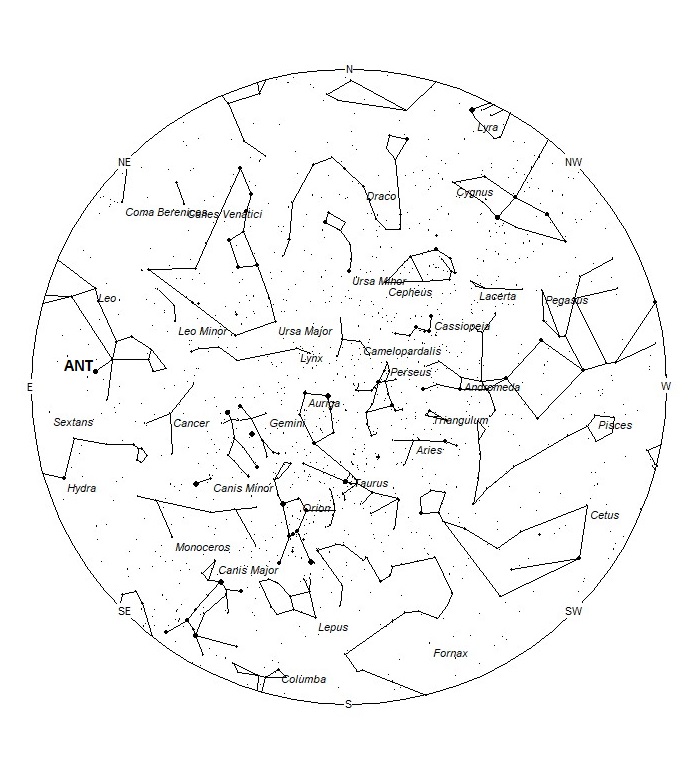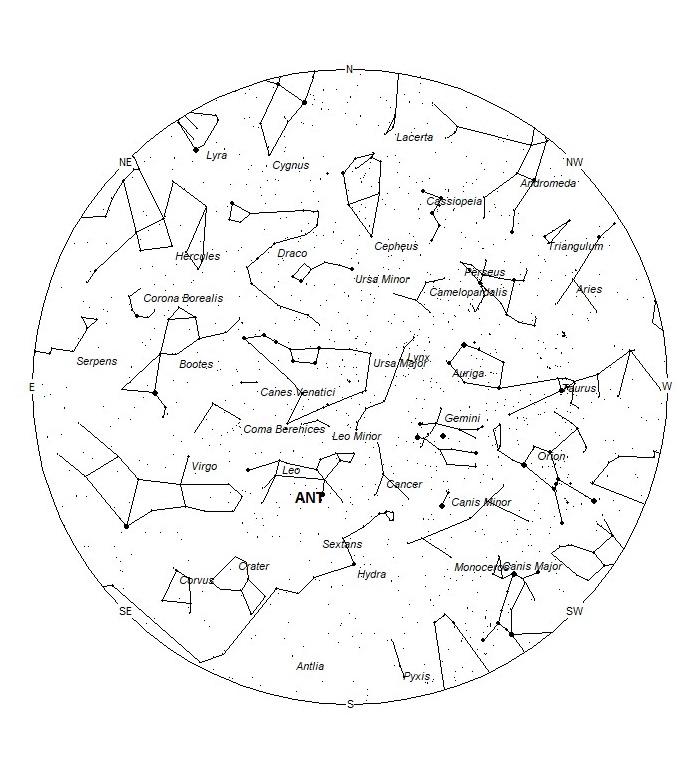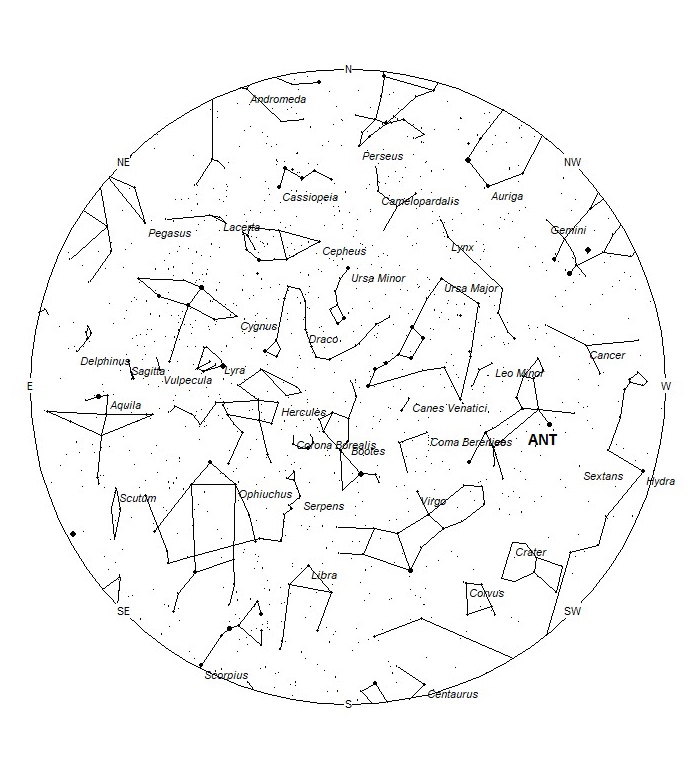During this period, the moon reaches its full phase on Wednesday February 16th. At that time the moon lies opposite the sun and remains in the sky all night long. This weekend the waxing gibbous moon will set during the early morning hours, leaving a couple of hours to view in dark skies prior to dawn. The estimated total hourly meteor rates for evening observers this week is near 2 as seen from mid-northern latitudes (45N) and 3 as seen from tropical southern locations (25S). For morning observers, the estimated total hourly rates should be near 9 as seen from mid-northern latitudes (45N) and 15 as seen from tropical southern locations (25S). The actual rates will also depend on factors such as personal light and motion perception, local weather conditions, alertness, and experience in watching meteor activity. Evening rates are reduced due to moonlight. Note that the hourly rates listed below are estimates as viewed from dark sky sites away from urban light sources. Observers viewing from urban areas will see less activity as only the brighter meteors will be visible from such locations.
The radiant (the area of the sky where meteors appear to shoot from) positions and rates listed below are exact for Saturday night/Sunday morning February 12/13. These positions do not change greatly day to day so the listed coordinates may be used during this entire period. Most star atlases (available at science stores and planetariums) will provide maps with grid lines of the celestial coordinates so that you may find out exactly where these positions are located in the sky. I have also included charts of the sky that display the radiant positions for evening, midnight, and morning. The center of each chart is the sky directly overhead at the appropriate hour. These charts are oriented for facing south but can be used for any direction by rotating the charts to the desired direction. A planisphere or computer planetarium program is also useful in showing the sky at any time of night on any date of the year. Activity from each radiant is best seen when it is positioned highest in the sky, either due north or south along the meridian, depending on your latitude. It must be remembered that meteor activity is rarely seen at the radiant position. Rather they shoot outwards from the radiant, so it is best to center your field of view so that the radiant lies at the edge and not the center. Viewing there will allow you to easily trace the path of each meteor back to the radiant (if it is a shower member) or in another direction if it is sporadic. Meteor activity is not seen from radiants that are located far below the horizon. The positions below are listed in a west to east manner in order of right ascension (celestial longitude). The positions listed first are located further west therefore are accessible earlier in the night while those listed further down the list rise later in the night.
These sources of meteoric activity are expected to be active this week.
The large Anthelion (ANT) is currently centered at 10:28 (157) +10. This position lies in western Leo, just 3 degrees southeast of the 1st magnitude star known as Regulus (alpha Leonis). Due to the large size of this radiant, these meteors may also be seen from Cancer and Sextans as well as Leo. This radiant is best placed near 01:00 local standard time (LST) when it lies on the meridian and is highest in the sky. Rates at this time should be near 2 per hour as seen from the northern hemisphere and 1 per hour as seen from south of the equator. With an entry velocity of 30 km/sec., the average Anthelion meteor would be of slow velocity.
The gamma Crucids (GCR) were discovered in 2021 by the CAMS system of meteor cameras managed by Dr. Peter Jenniskens. This shower is active from February 11-15 with a peak on the 14th. At maximum, the radiant is located at 12:32 (193) -56. This area of the sky is located in northern Crux, only 1 degree north of the 2nd magnitude star known as Gacrux (gamma Crucis). Observers in the Southern Hemisphere are greatly favored in seeing these meteors as the radiant does not clear the horizon for the northern two-thirds of the Northern Hemisphere. 40 of these meteors were captured in 2021, but this year the nearly full moon will hamper visual observations. I would expect hourly rates near 1 during the last hour prior to dawn as seen from the deep Southern Hemisphere. With an entry velocity of 56 km/sec., the average meteor from this source would be swift.
The alpha Centaurids (ACE) are active from January 31-February 20, with maximum activity occurring on February 8th. The radiant is currently located at 14:32 (218) -61. This position lies in southeastern Centaurus, 2 degrees west of the zero-magnitude star known as Rigel Kentaurus (alpha Centauri). Due to the southern declination of this radiant, these meteors are not well seen in the northern hemisphere. Current hourly rates are expected to be less than 1 as seen from the Northern Hemisphere and near 1 as seen from south of the equator. These meteors are best seen near 05:00 LST when the radiant lies highest above the horizon. At 56 km/sec. the alpha Centaurids would produce mostly swift meteors.
As seen from the mid-northern hemisphere (45N) one would expect to see approximately 7 sporadic meteors per hour during the last hour before dawn as seen from rural observing sites. Evening rates would be near 1 per hour. As seen from the tropical southern latitudes (25S), morning rates should be near 12 per hour as seen from rural observing sites and 2 per hour during the evening hours. Locations between these two extremes would see activity between the listed figures. Evening rates are reduced by moonlight during this period.
You can keep track of the activity of these meteor showers as well as those beyond the limits of visual observing by visiting the NASA Meteor Shower Portal available at: https://meteorshowers.seti.org/ You can move the sky globe to see different areas of the sky. Colored dots indicate shower meteors while white dots indicate sporadic (random) activity. The large orange disk indicates the position of the sun so little activity will be seen in that area of the sky.
| SHOWER | DATE OF MAXIMUM ACTIVITY | CELESTIAL POSITION | ENTRY VELOCITY | CULMINATION | HOURLY RATE | CLASS |
| RA (RA in Deg.) DEC | Km/Sec | Local Standard Time | North-South | |||
| Anthelions (ANT) | — | 10:28 (157) +10 | 30 | 01:00 | 2 – 1 | II |
| gamma Crucids (GCR) | Feb 14 | 12:32 (193) -56 | 56 | 03:00 | <1 – 1 | III |
| alpha Centaurids (ACE) | Feb 08 | 14:32 (218) -61 | 56 | 05:00 | <1 – 1 | II |




